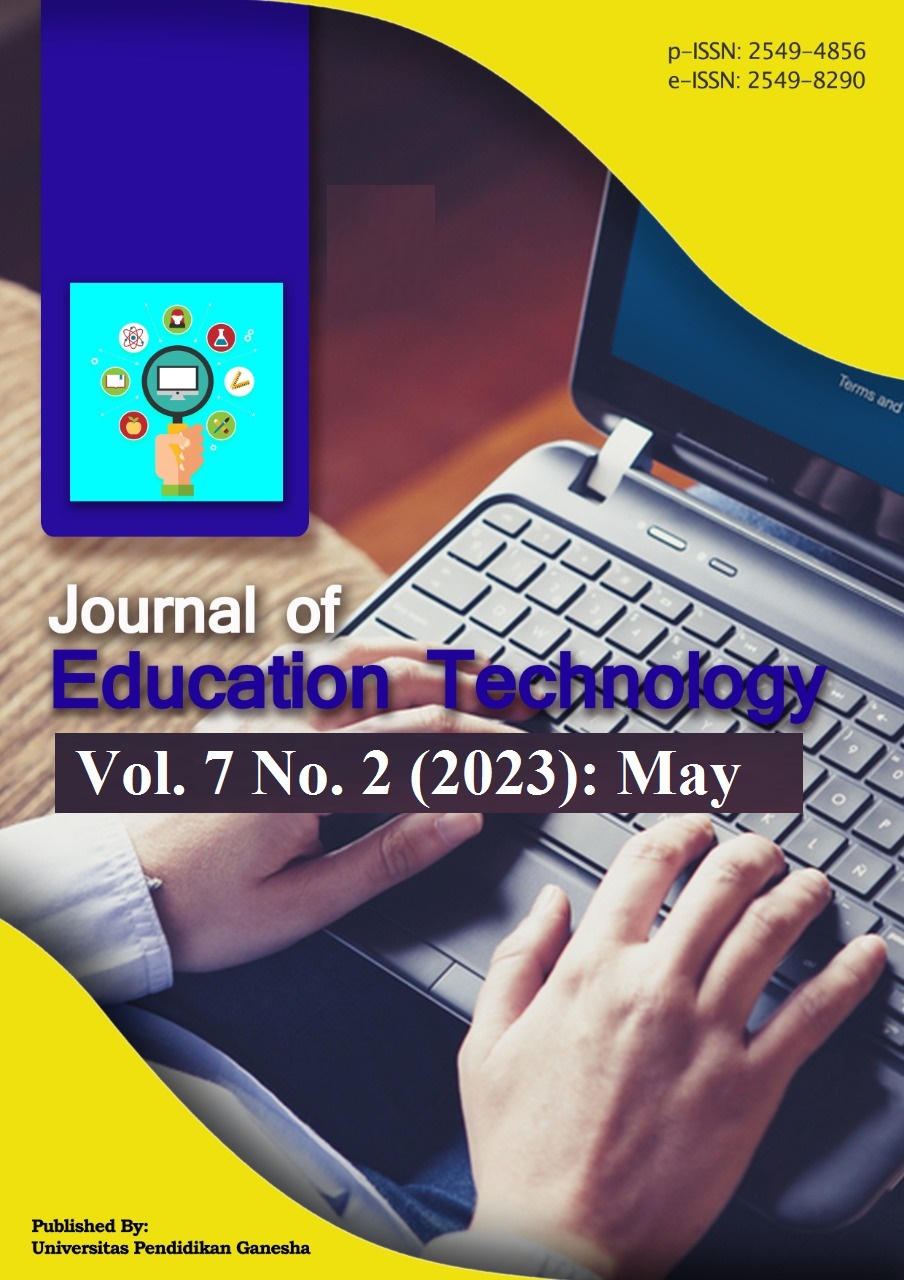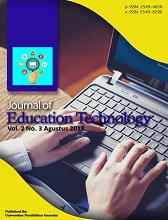Predictors of Enrolment Intention on Social Media: Guidelines for Universities
DOI:
https://doi.org/10.23887/jet.v7i2.57247Keywords:
social media, enrolement intention, social media engagement, prospective studentsAbstract
Globally, a vast majority higher education institutions are using social media in their day-to-day activities. Consequently, the need for guidelines to effectively use social media in student recruitment has become a necessity as universities compete among themselves. However, guidelines to use social media are scarce, especially in the realm of higher education and student recruitment. This study analyze social media guidelines by determining the predictors of enrolment intention when social media are used during student recruitment. Literature review revealed the existence of five constructs that may be associated with the intention to enrol at a university. A questionnaire was developed and administered to a sample of students from the four public universities. A total of 412 questionnaires were analysed using multiple linear regression and it was found that there are four predictors of enrolment intention, namely social media functionalities, social media engagement, social media content and information needs. From the predictors of enrolment intention and from the descriptive findings of this study, and additional literature, social media guidelines were derived and were recommended to be used by universities during student recruitment.
References
Aichner, T., Grünfelder, M., Maurer, O., & Jegeni, D. (2021). Twenty-Five Years of Social Media: A Review of Social Media Applications and Definitions from 1994 to 2019. Cyberpsychology, Behavior, and Social Networking, 24(4), 215–222. https://doi.org/10.1089/cyber.2020.0134.
Ait Lamkadem, S., & Ouiddad, S. (2021). Towards creating an effective customer brand engagement through social media marketing: A model proposal social media marketing. International Journal of Business and Management Invention (IJBMI), 10, 28–36. https://doi.org/10.35629/8028-1004012836.
Al-Thagafi, A., Mannion, M., & Siddiqui, N. (2020). Digital marketing for Saudi Arabian university student. Journal of Applied Research in Higher Education, 12(5), 1147–1159. https://doi.org/10.1108/jarhe-05-2019-0119.
Cant, M. C. (2016). Using social media to market a promotional event to SMEs: Opportunity or wasted effort? Problems and Perspectives in Management, 14(4). https://doi.org/10.21511/ppm.14(4).2016.09.
Capriotti, P., Zeler, I., & Camilleri, M. A. (2021). Corporate Communication Through Social Networks: The Identification of the Key Dimensions for Dialogic Communication. In Strategic Corporate Communication in the Digital Age, 33–51. https://doi.org/10.1108/978-1-80071-264-520211003.
Carr, C. T., & Hayes, R. A. (2015). Social Media: Defining, Developing, and Divining. Atlantic Journal of Communication, 23(1), 46–65. https://doi.org/10.1080/15456870.2015.972282.
Chawla, Y., & Chodak, G. (2015). Social media marketing for businesses: Organic promotions of web-links on Facebook. Journal of Business Research, 135, 49–65. https://doi.org/10.1016/j.jbusres.2021.06.020.
Chen, E., & Divall, M. (2018). Social media as an engagement tool for schools and colleges of pharmacy. American, 82(4), 354–364. https://doi.org/10.5688/ajpe6562.
Condie, A., Chowdhury, P., & Cooper. (2018). Personalizing twitter communication: an evaluation of rotation-curation’ for enhancing social media engagement within higher education. Journal of Pharmaceutical Education, 82(4), 354–364. https://doi.org/10.5688/ajpe6562.
Cordero-Gutiérrez, R., & Lahuerta-Otero, E. (2020). Social media advertising efficiency on higher education programs. Spanish Journal of Marketing - ESIC, 247–262. https://doi.org/10.1108/SJME-09-2019-0075.
Dagli, G., Altinay, F., Altinay, Z., & Altinay, M. (2021). Evaluation of higher education services: social media learning. International Journal of Information and Learning Technology, 38(1), 147–159. https://doi.org/10.1108/IJILT-03-2020-0032.
Dai, B., Ali, A., & Wang, H. (2020). Exploring information avoidance intention of social media users: a cognition affect–conation perspective. Internet Research, 30(5), 1455–1478. https://doi.org/10.1108/INTR-06-2019-0225.
Diba, H., Vella, J. M., & Abratt, R. (2019). Social media influence on the B2B buying process. Journal of Business and Industrial Marketing, 34(7), 1482–1496. https://doi.org/10.1108/JBIM-12-2018-0403.
Dolan, R., Conduit, J., Frethey-Bentham, C., Fahy, J., & Goodman, S. (2019). Social media engagement behavior: A framework for engaging customers through social media content. European Journal of Marketing, 53(10), 2213–2243. https://doi.org/10.1108/EJM-03-2017-0182.
Hutchinson, J. (2016). An introduction to digital media research methods: how to research and the implications of new media data. Communication Research and Practice, 2(1), 1–6. https://doi.org/10.1080/22041451.2016.1155307.
Jędrzejczyk, W. (2021). Barriers in the Use of Social Media in Managing the Image of Educational Institutions. Procedia Computer Science, 192, 1904–1913. https://doi.org/10.1016/j.procs.2021.08.196.
Kietzmann, J. H., Hermkens, K., McCarthy, I. P., & Silvestre, B. S. (2011). Social media? Get serious! Understanding the functional building blocks of social media. Business Horizons, 54(3), 241–251. https://doi.org/10.1016/j.bushor.2011.01.005.
Lai, C. H., Bin, S. J., T.H., Y., & Tsong, W. L. (2020). “Integrating Flash Cards with Narratives for Mobile Learning of English Vocabulary.” International Journal of Interactive Mobile Technologies, 14(4), 4–16,. https://doi.org/10.3991/IJIM.V14I04.11723.
Laumer, S., & Maier, C. (2021). Social Media Stress: A Literature Review and Future Research Directions. Information Technology in Organisations and Societies: Multidisciplinary Perspectives from AI to Technostress, 203–242. https://doi.org/10.1108/978-1-83909-812-320211008.
Liao, L., & Huang, T. (2021). The effect of different social media marketing channels and events on movie box office: An elaboration likelihood model perspective. Information and Management, 58(7). https://doi.org/10.1016/j.im.2021.103481.
Malhotra, N. K. (n.d.). Marketing research: an applied orientation (6th ed.). Pearson.
Mazurek, G., Korzyński, P., & Górska, A. (2019). Social Media in the Marketing of Higher Education Institutions in Poland: Preliminary Empirical Studies Institutions in Poland: Preliminary Empirical Studies. Entrepreneurial Business and Economics Review, 7(1), 117–133. https://doi.org/10.15678/EBER.2019.070107.
Motahari-Nezhad, H., Shekofteh, M., & Andalib-Kondori, M. (2021). Social media as a platform for Global Knowledge, Memory and Communication information and support for coronavirus: analysis of COVID-19 Facebook groups. Global Knowledge, Memory and Communication, 71(8), 772–788. https://doi.org/10.1108/GKMC-11-2020-0183.
Mwenda, A. B., Sullivan, M., & Grand, A. (2019). How do Australian universities market STEM courses in YouTube Videos? Journal of Marketing for Higher Education, 29(2), 191–208. https://doi.org/10.1080/08841241.2019.1633004.
Nanath, K., Sajjad, A., & Kaitheri, S. (n.d.). Decision-making system for higher education university selection: comparison of priorities pre- and post-COVID-19. Journal of Applied Research in Higher Education. https://doi.org/10.1108/JARHE-08-2020-0277.
Nguyen, C., Nguyen, N., & Duong, A. (2020). The Relationships of Social Media Marketing, Consumer Engagement and Purchase Intention. Test (Engineering & Management), 83, 24653– 24666. https://www.researchgate.net/profile/Cuong-Nguyen-79/publication/342976186_The_Relationships_of_Social_Media_Marketing_Consumer_Engagement_and_Purchase_Intention/links/5f3ccbcda6fdcccc43d32681/The-Relationships-of-Social-Media-Marketing-Consumer-Engagement-and-Purchase-Intention.pdf.
Nwedu, C. N. (2019). Strategies and Opportunities for Student Recruitment and Retention in African of Educational and Psychological Research. Universities: Lessons from Western Universities, 1(2), 1–9. https://www.researchgate.net/publication/337873752.
Oliveira, L. G. (2020). A framework for the development of social media content strategies for higher education institutions. Estudos Em Comunicacao, 30, 21–48. https://doi.org/10.25768/20.04.03.30.02.
Peruta, A., & Shields, A. B. (2018). Marketing your university on social media: a content analysis of Facebook post types and formats. Journal of Marketing for Higher Education, 28(2), 175–191. https://doi.org/10.1080/08841241.2018.1442896.
Rauniar, R., Rawski, G., Yang, J., & Johnson, B. (2014). Technology acceptance model (TAM) and social media usage: an empirical study on Facebook. Journal of Enterprise Information Management, 27(1), 6–30. https://doi.org/10.1108/JEIM-04-2012-0011.
Roopchund, R., Ramesh, V., & Jaunky, V. (2019). Use of social media for improving student engagement at université des mascareignes (UDM). Advances in Intelligent Systems and Computing, 863, 11–20. https://doi.org/10.1007/978-981-13-3338-5_2.
Sari, T. P., & Aras, M. (2021). Marketing Public Relations Program (MPR) for Creating the Brand Image of. Proceedings of the 2nd Southeast Asian Academic Forum on Sustainable Development (SEA-AFSID), 168. https://doi.org/10.2991/aebmr.k.210305.029.
Shields, A. B., & Peruta, A. (2019). Social media and the university decision. Journal of Marketing for Higher, 29(1). https://doi.org/10.1080/08841241.2018.1557778.
Ürer Erdil, D., Tümer, M., Nadiri, H., & Aghaei, I. (2021). Prioritizing Information Sources and Requirements in Students’ Choice of Higher Education Destination: Using AHP Analysis. SAGE Open, 11(2). https://doi.org/10.1177/21582440211015685.
Weiss, K. A., McDermott, M. A., & Hand, B. (2022). Characterising immersive argument-based inquiry learning environments in school-based education: A systematic literature review. Studies in Science Education, 58(1), 15–47. https://doi.org/10.1080/03057267 .2021.1897931.
Wu, D., & Zheng, J. (2023). Social media overload, gender differences and knowledge withholding. Kybernetes, 52(1), 24–43. https://doi.org/10.1108/K-06-2021-0482.
Zhu, Y. (2019). Social media engagement and Chinese international student recruitment: understanding. Journal of Marketing for Higher Education, 29(2), 173–190. https://doi.org/10.1080/08841241.2019.1633003.
Downloads
Published
How to Cite
Issue
Section
License
Copyright (c) 2023 Michael Cant, Joy

This work is licensed under a Creative Commons Attribution-ShareAlike 4.0 International License.
Authors who publish with the Journal of Education Technology agree to the following terms:
- Authors retain copyright and grant the journal the right of first publication with the work simultaneously licensed under a Creative Commons Attribution License (CC BY-SA 4.0) that allows others to share the work with an acknowledgment of the work's authorship and initial publication in this journal.
- Authors are able to enter into separate, additional contractual arrangements for the non-exclusive distribution of the journal's published version of the work (e.g., post it to an institutional repository or publish it in a book), with an acknowledgment of its initial publication in this journal.
- Authors are permitted and encouraged to post their work online (e.g., in institutional repositories or on their website) prior to and during the submission process, as it can lead to productive exchanges, as well as earlier and greater citation of published work. (See The Effect of Open Access)


















